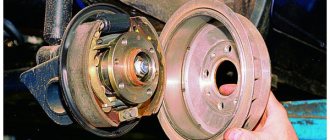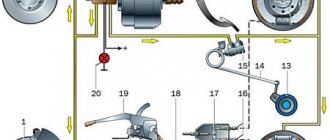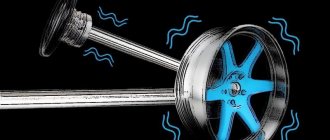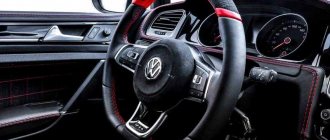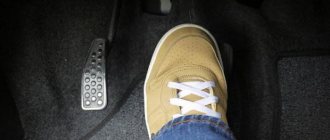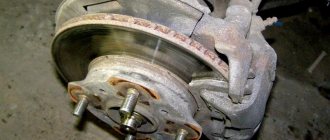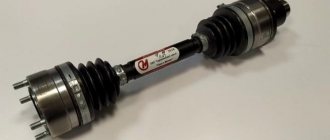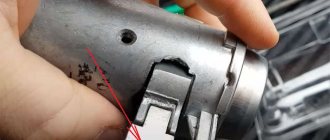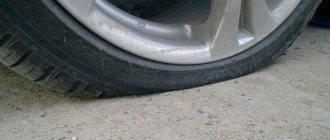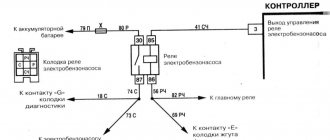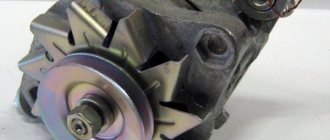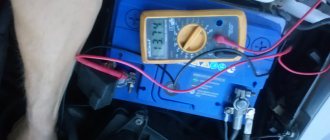I have a relatively new VAZ-2110. When braking at a speed of approximately 100 km/h, quite noticeable vibrations appear on the steering wheel. What causes them and how to eliminate this unpleasant phenomenon?
Alexander Mironov, Nizhny Novgorod
It would not have been easy to recognize the causes of this disease in garage conditions if the owners of VAZ 10s, based on their bitter experience, had not made an accurate diagnosis for it, and the garage telegraph had not notified newcomers that the dog was buried not in the steering, but in the brakes.
Diagnosis and medications
How is this disease treated? Those who are inclined to believe in miracles install new brake pads. In very rare cases, if the disease has not gone too far, this helps, but in most cases it is a waste of time and money (unless, of course, the old pads have been asking for replacement for a long time). It's like trying to get rid of a severe sore throat by sucking on mints.
Recommendations from garage “attending doctors”: you need to replace the brake discs with new ones. The recipe for those who have used this “medicine” more than once: install only imported discs, because our new discs, especially those purchased on the market, can have more runout than the old ones installed on the assembly line, and the metal of domestic brake discs is often “raw” ”, easily amenable to “grinding” with brake pads and a mixture of road dust and sand.
OK then. We spent some money and installed the best imported wheels from a serious Western manufacturer. The result is fifty-fifty. Why? Yes, because the “illness” can sit even deeper in the body.
Case Study
So, “patient”: VAZ-2112, mileage 55 thousand km. Complaints: steering wheel shakes when braking at high speed. Preventive measures: the chassis and controls were checked, the left steering tip was replaced, the wheels were balanced. Treatment: replacement or grooving of brake discs.
He didn’t write out a prescription for buying new brake discs for the “patient”: he had to pay for it himself, and because of the presence of a powerful 16-valve engine, his discs were ventilated, which means they weren’t cheap. I decided to resort to surgical intervention - to sharpen the discs, their thickness is still acceptable, but it’s up to the turner to decide.
Attention: turning brake discs is a job that requires high qualifications, so trust it only to a highly qualified turner! The visible roughness of the working surfaces after grooving is not scary. The turner sharpened the discs, fortunately for me, the thickness of the discs was enough (let me remind you that the VAZ “tenth” family has a minimum permissible thickness of a ventilated disc - 17.8 mm, and a non-ventilated one - 10.8 mm).
Together with the turner we put the disks in place. They installed one. The mood is great. All that remains is to secure the caliper and install the wheel, but some worm is gnawing. I listened to my inner voice - it asks not to install the wheel, but to check the disc runout. No, this is necessary, you doubt the master’s qualifications?! Yes, these wheels from his hands are better than the new factory ones. And he presses his point: maybe there’s something else wrong there.
In short, we checked: the runout of the working surface of the disk is twenty-five hundredths! These are the times. Although the plant allows a larger value - fifteen hundred parts, why would I need such a noticeable beat on a fast car - look how the indicator needle jumps!
What's the matter? The bearing has nothing to do with it, we checked it. We remove the disk and measure the hub runout. Nightmare, eighteen hundred square meters are “walking”! That's it, we've arrived. Hello to VAZ and its suppliers.
The mood is at zero, but soon a rather bold thought comes: is it possible to grind the hub on the spot, like a part clamped in the chuck of a lathe, if the revolutions required for turning work are enough, of course? Turner: why can’t we, let’s try, but I can’t vouch for the result, this is the first time. In general, the subtext is this: if you are ready to experiment on your car, then please, but without a guarantee.
I give the good, but what, exactly, do I have to lose? One hell of a lot, this factory “gift” needs to be changed or sharpened, and to do this the hub must be pressed out, then pressed in (and this is a difficult task in garage conditions), a new bearing must be bought - but where is the guarantee that it is of high quality? Let’s experiment, I say: for you it’s experience, for me it’s a chance to get by with little blood, and it’s interesting, in the end, how the whole thing will end.
Discs
The most common cause of steering wheel wobble on the “ten” and all VAZ cars is brake discs. They may even be new, but from the factory have deviations in geometry, hence the problems. It is almost impossible to check this visually when purchasing; you need to either look for branded spare parts, or try different batches, try to find disks from older cars.
If the brake discs are crooked, it can hit not only the steering wheel, but also the brake pedal. But with severe wear, vibration usually goes mainly to the steering wheel. Naturally, when replacing discs, you should immediately change the pads and check the calipers; there should be no play or varying degrees of fit.
In principle, approximately 85% of runout cases occur in the discs and brake mechanism. It’s also worth checking all the caliper fastening units, maybe a bolt has been cut off somewhere or has become unscrewed.
Hitting the steering wheel at speed
No self-respecting mechanic will fix a car “over the phone.” That is, if you tell him that your car is hitting the steering wheel at high speed, many questions immediately arise, in what mode this happens, when maneuvering, turning, changing gears and others, without knowing the answers to which no specialist can give you an exact answer will not give.
These problems can cause impacts on the steering wheel at speed:
- Lack of wheel balancing and incorrect camber or toe-in, it turns out that the weight of the wheels at different points does not match, at a speed of over 120 km/h the influence of centrifugal forces begins, so one of the wheels is pulled to the side, which causes vibration and beating in the steering wheel.
- The presence of a “bump” on the tire causes the wheel to become uneven and hit the surface, which is especially felt at speed when the steering wheel wobbles.
- The wheel bearing is damaged and there is play. Such a bearing ensures smooth rotation of the wheel, but when it breaks, the wheel begins to vibrate, which is felt by the beating of the steering wheel. Bearing failure may be accompanied by a squeaking or grinding noise.
- The uneven wear of tires at low speed is not felt, but if you accelerate strongly, you will feel vibration in the steering wheel. The wheels begin to wobble, and this effect is created. This violation is a consequence of not timely adjustment of the toe-in and camber of the wheels. Have you ever adjusted and balanced the wheels on your car? If it’s been a long time, then the effect is expected.
- Insufficient tire pressure at speed has the same effect. One wheel has flattened more, so it doesn’t spring enough and doesn’t absorb shock, which reverberates in the steering wheel.
- Severe deformation of the wheel rims can be felt at speeds of 100 km/h and above, and the vibration spreads throughout the vehicle.
- Play in the steering mechanism is felt by shocks when cornering when the load on it increases.
- The knock caused by rods or ball joints is also more noticeable when maneuvering when they are engaged.
- The knocking from the stabilizers is noticeable during sharp turns, drifts, and also on sharp turns when they are engaged.
- Vibration from the cardan is felt at high speeds and when the car is well loaded.
Wheels and chassis
The VAZ-2110 and the entire family, due to front-wheel drive, experience increased load on the front wheels. It is imperative to do balancing, as well as check the condition of the nuts, hub, and the chassis as a whole.
Quite often the wheel itself hits when braking. And not because of balancing, but because of broken bolts and holes. You can try to remove the wheel, move it one bolt forward in a circle, and check the result. Some people wrap one turn of electrical tape, this helps at least diagnose the problem. If the problem disappears for a short time, then the problem is with the disks and fasteners.
Steering rods, steering knuckles, ball joints, levers - all this needs to be tugged on the lift to check for play. Again, when driving, you should carefully listen to the operation of the suspension on turns or bumps. After the trip, check the same hubs by hand for heating.
In principle, the VAZ-2110 is such a car that if there is no steering wheel beat at speeds up to 90 km/h, then this is normal. Driving it at a higher speed is in any case dangerous, even if the chassis is in perfect condition - the issue here is the quality of the parts and the generally weak strength of the car.
A car is a high-risk vehicle. When driving, all controls must be in working order. However, it happens that the steering wheel vibrates when braking. Opel Astra is also not immune to this problem. Let's look at the causes of this malfunction and how to eliminate them.
How to eliminate runout?
When your car's steering wheel vibrates slightly during heavy braking, you can simply do nothing and drive on, taking appropriate safety measures. The trick is to avoid decelerating too quickly, otherwise the problem will get worse and you risk losing your vigilance and running off the road.
Recommendation. Before further operation of the car, make sure that the culprit of the steering wheel runout is a defect in the brake disc, and not other reasons.
If the beating is quite noticeable and really threatens the safety of people (vehicle passengers and pedestrians), the deformed disk should be replaced or restored. The first way is associated with significant financial costs - spare parts for some brands of cars are quite expensive. In addition, the brake discs must be replaced in pairs, otherwise during moments of sharp deceleration the front part of the car will begin to pull to the side.
Disc restoration involves turning on a specialized machine . The equipment of advanced service stations makes it possible to process metal without removing the defective part from the machine. The procedure will be cheaper than purchasing and installing new spare parts.
When the car shakes when braking, regardless of speed, you need to look for and fix the problem elsewhere:
- Make sure that the linings of the rear and front wheels are not flooded with brake fluid. A secondary symptom is a decrease in its level in the expansion tank.
- Check the functionality of the brake calipers and wheel cylinders. The cause of vibration is often a jammed piston, and fluid leaks are often caused by a leaky cuff.
- Sometimes the steering wheel starts to vibrate after replacing the pads. This symptom indicates low quality of installed spare parts.
In some cases, vibration appears due to broken brake pads. The malfunction is accompanied by an extraneous sound of grinding or rubbing against metal.
Wheel balancing
If your steering wheel vibrates when braking at speed, the first thing to blame is the drive wheels. They may be loose or out of balance. Check the presence of weights on the disk - if one of them falls off, the problem can be solved with one visit to the tire shop. You cannot perform this operation yourself. And it’s inexpensive, so first we pay attention to balancing. It happens that the weights remain in place, but the disk is bent when it hits a hole. In this case, repair will help. In the case of stamped products, they can be aligned without welding.
Procedure when vibration occurs
Check brake pads and tire pressure
First you need to look at the problem superficially. Sometimes vibration can occur due to a simple hernia on a tire or improper wheel balancing. This point must be checked immediately. Indeed, during the rotation of the wheel, the area with greater gravity will pull the center towards itself, provoking the emergence of centrifugal force.
If the problem is not with the tires or the balancing, it is recommended to check the quality of the components. Often, especially when a car is purchased second-hand, you can find cheap and low-quality components in the brake system that were installed by the previous owner in order to prepare the car for sale at a minimal cost. If you have frankly cheap brake pads and similar elements, it is better to replace them immediately.
The fact is that the material of low-quality brake pads can wear off and remain on the surface of the disc, which slightly changes its thickness, since the distribution is uneven. This also causes vibration when braking. To begin with, you can try removing dirt with a brush. If this does not help, the disc, along with the pads, will have to be replaced.
It is no secret that grinding in brake pads occurs during the first 200 km, during which it is necessary to move measuredly and brake smoothly. If these recommendations are not followed, the friction material on the pads wears unevenly, which can cause vibrations.
If tire pressure is uneven, vibrations can be transmitted to the steering wheel. You need to stop and check the pressure using a pressure gauge.
Check discs for wear and overheating
Overheating/deformation of the front brake discs
Despite the fact that the design and design of modern brake discs allows them to cool quickly enough, during intense braking there is not enough time to remove the heat resulting from friction and the disc overheats.
In this case, blue thermal spots appear on the shiny surface of the disk, and it becomes deformed. Such a defect cannot be corrected and the disk should be replaced immediately. In this case, it is unacceptable to leave the existing brake pads. In this case, they are changed along with the disk.
Owners rarely pay attention to the thickness of brake discs. As a result, the latter become so worn out that they are unable to perform their task. If there are wide edges around the edge, it is recommended to measure the thickness of the disks and compare it with the minimum allowable. It is not uncommon for vibrations to occur due to excessive wear on the disc. If there is a supply, it would not be a bad idea to polish the components by giving them to a professional turner.
In addition, cases of disc deformation are not uncommon on domestic roads. After all, it is enough to drive into a hole at speed once to deform the disc. In addition, it is by no means necessary that the curvature will be noticeable visually - often this is visible only on a special stand. In some cases, the disk can be optimized and aligned, and sometimes it has to be replaced.
Check calipers and hubs
In this case, the rubber cuffs often tear, causing the caliper guides to jam. In this case, you can disassemble them yourself, replace the cuffs and reassemble them.
Pads
Next, we inspect the brake system, namely the pads. Since the steering wheel controls the front wheels, we look at the condition of the pads on them. Why does the steering wheel vibrate when braking in this case? The pads wear out a lot. The friction material wears down to the linings, and then the metal part rubs against the disc. As a result, the steering wheel vibrates when braking.
The VAZ-2110 is equipped with a reliable braking system, but it may also require repairs if consumables are not replaced in a timely manner. The pads need to be changed every 20-25 thousand kilometers. If you have an aggressive driving style, divide this figure by 2. After installing new pads, run it in - brake smoothly and without jerking for 200 kilometers. This is necessary so that the new material gets used to the working surface. Remember that the front pads wear out several times more often than the rear ones.
Wear can be determined by the grooves: when the pads have worn down to them, they need to be replaced. Well, if the friction material has worn down to the metal linings, urgently buy pads, since during the next braking the caliper may simply jam and the car will skid. The replacement is also indicated by a characteristic creaking noise when braking. Sometimes this happens due to poor friction material or when water gets on its surface. After washing the car, thoroughly dry the brakes by briefly pressing the pedal.
Body vibration when braking VAZ 2110
- To the beginning of the forum
- Forum Rules
- Old design
- FAQ
- Search
- Users
Good day to all.
Somehow I can’t overcome the vibration on the front wheels. This is the situation. When braking, the steering wheel and the car wobble; when braking smoothly, the car slows down in noticeable waves! I did the wheel alignment 2 times, replaced the pads + brake discs (enough for 500 km), before that the wheel bearings were changed. With the car raised, the front wheels touch the pads unevenly (in waves) when rotating.
What I thought was that the service could have somehow pressed the wheel bearing in incorrectly. Although there is too much contact surface between the bearing and the fist for it to stand crooked. Or maybe there’s something wrong with the hub, it’s somehow crooked.
The wheels are in good condition, without any play. In short, HELPPPPP.
System16v
The tires are new, I balanced them 5 times. It’s not the problem... I’m already tired of something, it seems like I’ve already gone through everything. I took everything apart twice and checked to see if anything had gotten under the brake discs.. To see if the brake calipers were crooked, etc.
Before replacing the wheel bearings, there was never any vibration when braking. Something similar happened when the rear drums became “square”. Now it’s not about them, you use the handbrake. everything is fine, no vibration. When I installed new brake discs, the vibration also disappeared for a while. So the problem is somewhere there, something is wrong there. The complete fist costs 2k. thing
If you can’t drive the hub further into the bearing (perhaps it didn’t go all the way in), you’ll probably have to buy everything assembled(
Before replacing the wheel bearings there was never any vibration when braking
So that's the reason. Shitty installation.
Replace with new ones (you’ll ruin the old ones anyway).
!Lnur
I just don't understand how the bearing could have been installed incorrectly. The bearing in the fist is too tight for a crooked installation; the contact patch covers the entire bearing, so to speak. I don't understand how. Maybe they didn’t reach the hub yet, I’ll try to press it in with a sledgehammer.
PS Once again I am convinced of the correctness of the proverb “If you want to do it well, do it yourself.” Only crooked freaks work in the services. I did it at the service center only because there was nothing to press out the bearing with.
The runout is not due to a crooked installation, but due to play in the bearing. The play happened because dirt got between the two halves of the inner race and they did not tighten or the bearing was “damaged” during installation.
First, determine which wheel is loose.
!Lnur
That's the thing, the wheels are dead. There is no play, the hub itself somehow rotates crookedly (maybe it seems). Now I tightened the hub nut with a wrench with a two-meter extension, as they say from the navel. Let's see what happens.
To begin with, I'll start small, replacing the rear drums and pads just in case. If it doesn't, I'll start picking the hub.
PS It’s these small shoals that irritate the basins, you can drive but it’s terribly annoying. I want a Mercedes
alver_tmb
Yeah, the pedal jumps too. For this reason, I’ll start small and replace the drums. It’s painfully similar to how it was with them before, although back then everything was easily determined with the handbrake. Now, when braking with the handbrake, there seems to be no vibration.
Well, what if replacing drums, knuckles and brake discs does not help? It's absolutely worth selling. Changing everything will cost more than a new car
Source
Dirt inside
Sometimes sand and dust that gets on the working surface of the brake elements can cause vibrations. This happens especially often in rainy weather, when dirt sticks to the disc along with water. Over time, it dries and forms a hard layer. It can serve as a counterbalance weight, causing your steering wheel to vibrate when braking. Sometimes dirt gets on the inside of the disc or on the wheel flange. The solution to the problem is high-quality washing of the brake system elements under high water pressure.
conclusions
Knowing these points, the owner can independently identify the reasons why the steering wheel of his VAZ-2112 car occurs when braking or at speed. If you cannot identify the reasons yourself, you should contact a service station. Operating a car with such a malfunction is dangerous!
Usually, beating when braking indicates poor condition of the brake discs and driving style. The brakes overheat - the discs warp. that's all. And it would be a good idea to check the condition of the steering linkage. It’s better to replace the discs; you don’t have to try to sharpen them or somehow “farm” them.
If it beats, then this is a signal from the machine that something is wrong. Essentially, these are imbalances and in this case it is the pads that are the problem.
And if the pads and brake discs are new, and the alignment is done. And still, at high speed with smooth braking, there is a beating in the steering wheel. What could this be? And by the way, the steering rack is also tightened, the wheel balancing is normal. What could it be? There is a person who knows what could be the cause of the malfunction.
everything is in order of queue; 1 tires, wheels. 2 brake discs, pads. 3 steering rack, rods. 4 ball. 5 silent blocks in a circle (crab, saber). 6 wheel bearing.
It was also beating. VAZ 12. I changed the drive assembly with grenades, I changed the disks 2 times in a year. The other day I changed the hub bearing, there was no noise, but I didn’t like it. It got hotter and the wheel spun worse when suspended. It became much better. I’ll change the steering ends in an hour and do the alignment. 1 is out of order. A lot also depends on this.
new discs and pads! It hits when braking at a speed of 60 -70 what is the reason.
I had an internal joint on 10k, and it didn’t even crunch, but it’s easy to check by pulling it from the pit
To be honest, in the worst cases, the beating when braking, especially at high speed, is the wheels if it hits the steering wheel, and if it hits the brake pedal, then look at the rear drums or pads..
90% of the beating in the steering wheel is the rack, I replaced it with a used one. and the beating began too.
Steering rods
If there are vibrations, inspect the steering linkages. When the tips wear out and wear out, these elements begin to vibrate during braking. How to check them? For this you will need an assistant. He must hold the steering wheel firmly. At this time, you pull the steering rods from side to side (with the car jacked up). There should be no backlash.
If there is free play, this rod must be replaced. Another sign of a faulty element is poor vehicle handling. The steering wheel becomes sluggish. After replacing the steering rods, be sure to normalize the wheel alignment to prevent uneven tire wear.
Malfunction of engine mounts
Malfunctions of engine mounts are quite rare. It manifests itself in the initial stage as subtle vibration at idle and during straight-line movement at low and medium engine speeds. But with sharp acceleration and driving at high engine speeds, vibration occurs, which is transmitted through the car body. The test can be carried out with the vehicle running; an assistant will be required to perform the test. We place the car on a flat area with good lighting, secure it with the parking brake and start the engine. Warm up to operating temperature and stable idle speed. We open the hood of the car and gradually increase the engine speed to maximum, while observing the behavior of the engine relative to the rest of the compartment layout. Next, we make several throttle changes to maximum speed. If the Ford Focus 2 engine has significant deviations from the axis, then you should contact the service for further consultation with specialists and repairs. We check for wear or damage to the rear cushion securing the gearbox when reversing. When accelerating sharply, the car begins to vibrate and twitch strongly. You can replace worn out pillows on your own, but it is better to carry out this operation at a car service center. It should be borne in mind that the power unit mounting cushions should all be changed at the same time.
Source
Cardan transmission
On many cars there is a small universal joint in the steering column. It also needs to be examined. You can get to it by removing the protective casing of the column. The element is located in the place where it enters the body. If the cardan shaft is loose, there is wear on it. After replacing this element, the steering wheel no longer vibrates when braking. This does not happen often, but such a malfunction cannot be ruled out.
Example from life
VAZ 2112 car with mileage of 55 thousand km. When trying to brake at high speed, a strong shaking of the steering wheel occurs. During preventive measures, the vehicle's chassis and controls were checked. Based on the test results, the steering tip on the left side was replaced and the wheels were balanced. However, to eliminate the problem, it is necessary to grind or replace the brake discs.
It should be noted that turning brake discs should only be done by a qualified technician, so do not trust this serious operation to the first turner you come across. Also, you should not pay serious attention to some surface roughness after grooving; it is absolutely not dangerous.
Typically, the thickness of the brake disc is sufficient for grooving. Let us recall that for the VAZ 2110 and similar cars the acceptable thickness of a ventilated disc is 17.8 mm, the same figure for a non-ventilated disc is 10.8 mm.
We install the disks together with an experienced turner. All that remains is to secure the caliper and then install the wheel in its place, however, something is haunting me. Intuition suggests that you should not rush to reinstall the wheel; you should first check the amount of runout of the brake disc. It happens: I doubt the qualifications of the master. As a rule, polished dikes are much better than factory copies. But still, intuition haunts me and requires rechecking.
After rechecking, it turned out that the amount of runout of the working surface of the brake disc is within twenty-five hundred meters. The manufacturer allows a value of fifteen hundred square meters. Question: “Why such a sensitive beat at high speed, which leads to the frantic movement of the indicator needle?”
We're trying to figure out what's going on. There is no point in sinning on the bearing, since it was subjected to additional rechecking. We dismantle the disk and once again measure the hub runout. Kick, as much as 18 acres! Fine! Hello to VAZ employees and all its suppliers...
Causes of brake pedal vibration on VAZ2110?
The brakes are worn out. The services don’t tell you exactly what to do until they move; they don’t want to look for the cause of the malfunction. I recently got my license and have no experience in repairs. My ten is 10 years old, mileage is 120,000. The problem is the following: at speeds above 20 km/h, when you press the brake pedal for a long time, the pedal begins to vibrate, and the higher the speed, the stronger the vibration. In this case, vibration is transmitted to the steering wheel. I changed the brake fluid completely, after replacing the vibrations decreased for a while, but did not disappear. The brake discs have wear, but it is small; when opening the drums, everything seems to be in order. The pads also seem to be ok. What could be the reason and how to determine that this particular part is faulty. I wouldn't want to change everything until the vibrations stop.
| sergbat |
| The user about whom you requested information is not registered in the system. The user about whom you requested information is not registered in the system. |
Body vibration when braking VAZ 2110
- To the beginning of the forum
- Forum Rules
- Old design
- FAQ
- Search
- Users
Good day, forum users!
I recently replaced the brake system and ran it in.
After the break-in, the brakes returned to normal, I was happy, but after a while the rear began to shake terribly when braking. Everything is fine in the front, only a slight wobble in the steering wheel at 100!
What to do with the rear brakes? What could be causing this and what should I do?:
front: brembo 14 fan perf. + ferodo red rear: Vladimir drums + VIS pads
So I installed new ones
What to do with the rear brakes?
[quote=”rn9fal”]Similar crap happened to me, almost immediately after purchase, with about 5k mileage. The drums were changed under warranty (the rear ones are replaced, the front discs are not, they immediately say that this is not a warranty case and there is no point in driving through puddles
. But they don’t give out wings). So that's what I'm talking about. And, here: replacing the drums did not lead to anything, the same knocking and terrible vibration. I spat on the downs in the service and went to dig this forum. So, somewhere around here this topic was floating around, and it was advised to thoroughly clean the “fender planes”, turn the drums 90 degrees, or even change their places. And the complex of these measures helped to completely get rid of the described effect, for which many thanks to the author of the advice :cool:[/quot
What are fender planes? Is this the plane between the drum and the shield to which the brake cylinder is attached? - or am I mistaken? How to clean these fender planes?
Source
The brake discs have wear, but it is small; when opening the drums, everything seems to be in order.
The reason is most likely in the rear brake drums. You can’t determine anything visually. Put it in a lathe and you will be surprised what an ellipse it is. Advice: Buy new rear brake drums and immediately take them to a turner, believe me, the new ones are also crooked. Remove the front brake discs and also take them to a turner. If the wear is not very great, he will sharpen them. If the wear is great, then go to the store and buy new ones, and again to the turner. After the groove, put it on and that’s it, nothing else will vibrate under your foot. Verified.
crusg. Cleveland (Oleg)| Car make: Subaru |
| Car model: Outback |
| Life values and hobbies: Videography - Art - Photography |
| as well as: Recreation - Travel |
| and also: Humor |
Articles (original)
The VAZ-2110 offers a fairly wide selection of brake discs.
- The original catalog number of the disk is 2110-3501070 (ventilated) or 2110-3501090 (non-ventilated).
- The average cost of a set of two products is 5,000 rubles.
New brake disc on the car.
Analogs
And this is what it looks like in the package (Trialli)
No less popular Trialli brake disc.
In addition to the original parts, the automotive market offers a fairly wide range of analogues, which in terms of quality and cost can cover the needs of any motorist.
Let's look at the table of manufacturers, catalog numbers and average prices for VAZ-2110 brake discs:
| Manufacturer | vendor code | Price in rubles for 1 piece |
| Profit | 5010-1142 | 1000 |
| Denckermann | B130406 | 1000 |
| Ferodo | DDF1142 | 1200 |
| LPR | L1053V | 1200 |
| Brembo | 09.8894.14 | 2000 |
| ABS | 17339 | 1500 |
| Metelli | 23-0553 | 1500 |
| Bosch | 0 986 479 082 | 1500 |
| Cifam | 800-553 | 1600 |
| Trialli | DF 135 | 1750 |
| Pilenga | 4221 SPORT | 1750 |
| Pilenga | V221 | 1200 |
| QML | BD1003 | 1300 |
| Valeo | 297781 | 1500 |
| TRW | DF4108 | 2000 |
| Allied Nippon | ADC1710V | 2000 |
| Hola | HD904 | 2000 |
| Textar | 92109200 | 3000 |
As you can see, the automotive spare parts market is quite wide, and if original wheels are expensive, then there is always the opportunity to buy an analogue.
Spherical bearing
After that, I checked the wheel shank on the ball joint - there was no shackle. To check the shank in the ball joint, it is necessary to jack up the car and place the ball joint on a static support standing on the ground, so that the wheel is completely in the air (you can use a steel cylinder, a wooden ingot, or a hydraulic jack as a support). Then take the upper part of the wheel with one hand, and the lower part of the wheel with the other hand and try to shake the wheel, pulling the upper and lower parts of the wheel towards you and away from you, respectively. If there is a shank, it means that the ball joint is worn and needs to be replaced.
Completion of work
Our experiment ended successfully, and the hubs have been time-tested - over the last year I have been driving without any beats. It’s just that the “ten-man”, asking a question about the beating of my steering wheel during high-speed braking, reminds me of a long-forgotten problem. Of course, sooner or later the brake discs will have to be changed by purchasing completely new ones, but this is a completely different story, since the whole problem will lie only in their choice.
Could the hub be faulty? Of course it can. Once, while repairing my car, I was very surprised by one circumstance. A slight runout of the hub can lead to quite noticeable runout of the brake disc. This is especially true for places that are as far away from the axle as possible, that is, for brake pads. In the case of high-speed braking, the brake pads strongly compress the disc rotating at high speed with the presence of irregularities, which leads to vibrations that are transmitted to the steering wheel through the tie rods, the steering lever and the steering mechanism itself.
Sources:
https://www.desyatki.ru/guide/x4/wbr/1/ https://wroom.ru/forum/topic/20437 https://novosti-online.info/3944-pochemu-pri-tormozhenii-bet -rul-na-vaz-2110.html https://carfrance.ru/pochemu-byot-v-rul-pri-tormozhenii-na-vaz-2112-prichiny-i-diagnostika/ https://howcarworks.ru/ %D0%B2%D0%BE%D0%BF%D1%80%D0%BE%D1%81/%D0%B2%D0%B8%D0%B1%D1%80%D0%B0%D1%86% D0%B8%D1%8F-%D0%B8%D0%BB%D0%B8-%D0%B1%D1%8C%D1%91%D1%82-%D1%80%D1%83%D0%BB %D1%8C-%D0%BF%D1%80%D0%B8-%D1%82%D0%BE%D1%80%D0%BC%D0%BE%D0%B6%D0%B5%D0%BD %D0%B8%D0%B8-%D0%B2-%D1%87%D1%91%D0%BC-%D0%BC%D0%BE%D0%B3%D1%83%D1%82-%D0 %B1%D1%8B%D1%82%D1%8C-%D0%BF%D1%80%D0%B8%D1%87%D0%B8%D0%BD%D1%8B https://mashintop.ru /articles.php?id=1544
